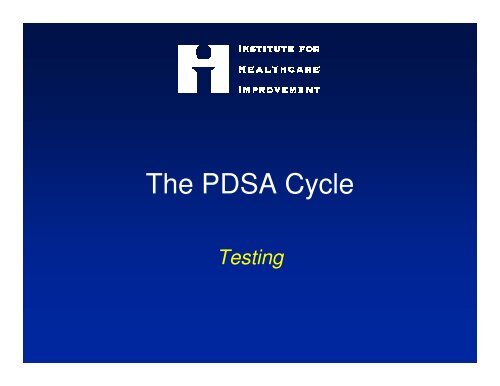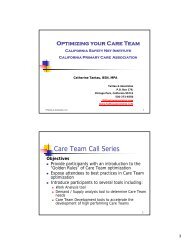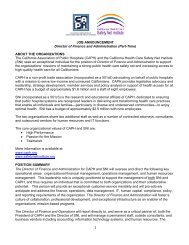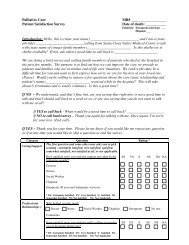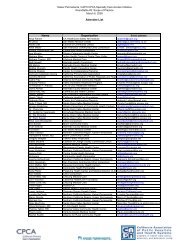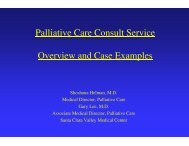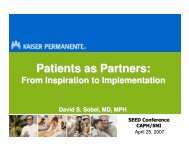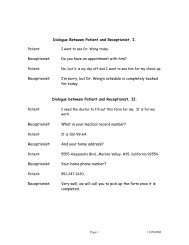The PDSA Cycle - Safety Net Institute
The PDSA Cycle - Safety Net Institute
The PDSA Cycle - Safety Net Institute
You also want an ePaper? Increase the reach of your titles
YUMPU automatically turns print PDFs into web optimized ePapers that Google loves.
<strong>The</strong> <strong>PDSA</strong> <strong>Cycle</strong><br />
Testing
Objectives<br />
• Identify parts of a complete <strong>PDSA</strong><br />
cycle<br />
• Plan a test of change<br />
• Identify ways to accelerate the rate<br />
of testing
Model for Improvement<br />
What are we trying to<br />
accomplish?<br />
How will we know that a<br />
change is an improvement?<br />
What change can we make that<br />
will result in improvement?<br />
Act<br />
Plan<br />
Study<br />
Do<br />
Source:: Associates in<br />
Process Improvement
<strong>The</strong> <strong>PDSA</strong> <strong>Cycle</strong><br />
Four Steps: Plan, Do, Study, Act<br />
Also known as:<br />
•Shewhart <strong>Cycle</strong><br />
•Deming <strong>Cycle</strong><br />
•Learning and<br />
Improvement <strong>Cycle</strong><br />
Act<br />
Study<br />
Plan<br />
Do
Principles for Testing a Change<br />
• Principle 1: Build knowledge sequentially<br />
– Test on a small scale<br />
– Use multiple cycles<br />
• Principle 2: Increase the ability to predict<br />
from the results of the test<br />
– Collect data over time<br />
– Test under a wide range of conditions
Repeated Use of the <strong>PDSA</strong> <strong>Cycle</strong><br />
Hunches<br />
<strong>The</strong>ories<br />
Ideas<br />
A P<br />
S D<br />
Very Small<br />
Scale Test<br />
DATA<br />
A P<br />
S D<br />
Follow-up<br />
Tests<br />
D S<br />
P A<br />
A P<br />
S D<br />
Wide-Scale<br />
Tests of<br />
Change<br />
Changes That<br />
Result in<br />
Improvement<br />
Implementation of<br />
Change
Series of <strong>PDSA</strong> <strong>Cycle</strong>s to<br />
Improve Access<br />
Improved Access<br />
Reduction of<br />
appointment types<br />
will increase<br />
appointment<br />
availability<br />
A P<br />
S D<br />
A P<br />
S D<br />
Data<br />
D S<br />
P A<br />
A P<br />
S D<br />
D S<br />
P A<br />
<strong>Cycle</strong> 5: Implement standards<br />
and monitor their use<br />
<strong>Cycle</strong> 4: Standardize appointment types<br />
and test their use<br />
<strong>Cycle</strong> 3: Test the types with 1-3 MDs’ patients<br />
<strong>Cycle</strong> 2: Compare requests for the types for one week<br />
<strong>Cycle</strong> 1: Define a small number of appointment types and test with staff
Series of <strong>PDSA</strong> <strong>Cycle</strong>s to Improve Routine<br />
Assessment & Care of High-risk Asthma Patients<br />
Peak flow<br />
meters for<br />
high-risk<br />
patients<br />
A P<br />
S D<br />
A P<br />
S D<br />
DATA<br />
D S<br />
P A<br />
A P<br />
S D<br />
D S<br />
P A<br />
Routine use of<br />
flow meters by<br />
high-risk patients<br />
<strong>Cycle</strong> 5: Monitor<br />
communication and use of<br />
flow meters with high-risk<br />
patients<br />
<strong>Cycle</strong> 4: Test understanding of use of<br />
flow meters by patients<br />
<strong>Cycle</strong> 3: Train providers on teaching patients to<br />
use flow meters<br />
<strong>Cycle</strong> 2: Test updated policy on distribution of flow meters<br />
<strong>Cycle</strong> 1:Test communication on use of flow meters with providers
Why Test?<br />
New concept for many teams:<br />
• Increase belief that the change will result in<br />
improvement<br />
• Document how much improvement can be<br />
expected from the change<br />
• Learn how to adapt the change to conditions<br />
in the local environment<br />
• Minimize resistance upon implementation<br />
• Evaluate costs and side-effects of the change
Model for Improvement<br />
Exercise
<strong>The</strong> Sequence Exercise<br />
• What rule generated the sequence?<br />
• What tests should we run?<br />
• How will we know if we have succeeded?<br />
• How do we learn?
What Did We Learn?<br />
• We want failures during testing…not during<br />
implementation!!<br />
– We want to learn reasons for failed tests<br />
Change not executed well - or at all!<br />
Support processes inadequate<br />
Hypothesis/hunch wrong:<br />
Change didn’t result in local improvement<br />
Or local improvement didn’t impact global measures<br />
• Need to collect data while testing so can<br />
differentiate<br />
• Sharing saves time!
Application of the <strong>PDSA</strong> <strong>Cycle</strong><br />
• Planning requires prediction<br />
• Prediction requires a theory<br />
• A single observation may require us to<br />
modify our theory<br />
• Multiple <strong>PDSA</strong> cycles can accelerate<br />
the learning process<br />
• Choice of plan depends on our “degree<br />
of belief” about the change
Techniques to Accelerate<br />
Testing<br />
• Plan multiple cycles for a test of a change
Concept Design to Implement the CCM for<br />
a Specific Chronic Population<br />
A P<br />
S D<br />
A P<br />
S D<br />
A P<br />
S D<br />
A P<br />
S D<br />
A P<br />
S D<br />
A P<br />
S D<br />
D S<br />
P A<br />
D S<br />
P A<br />
D S<br />
P A<br />
D S<br />
P A<br />
D S<br />
P A<br />
D S<br />
P A<br />
A P<br />
A P<br />
A P<br />
A P<br />
A P<br />
A P<br />
S D<br />
S D<br />
S D<br />
S D<br />
S D<br />
S D<br />
A P<br />
S D<br />
A P<br />
S D<br />
A P<br />
S D<br />
A P<br />
S D<br />
A P<br />
S D<br />
A P<br />
S D<br />
Community<br />
Resources<br />
and Policy<br />
Organization<br />
of<br />
Health<br />
Care<br />
Self-<br />
Management<br />
Support<br />
Delivery<br />
System<br />
Design<br />
Decision<br />
Support<br />
Clinical<br />
Information<br />
Systems
Techniques to Accelerate<br />
Testing<br />
• Plan multiple cycles for a test of a change<br />
• Think a couple of cycles ahead<br />
• Initially, scale down size of test (# of<br />
patients, location)
Decrease the Time Frame<br />
for a <strong>PDSA</strong> Test <strong>Cycle</strong><br />
• Years<br />
• Quarters<br />
• Months<br />
• Weeks<br />
Drop down next<br />
“two levels” to<br />
plan Test <strong>Cycle</strong>!<br />
• Days<br />
• Hours<br />
• Minutes
Techniques to Accelerate<br />
Testing<br />
• Plan multiple cycles for a test of a change<br />
• Think a couple of cycles ahead<br />
• Initially, scale down size of test (# of<br />
patients, location)<br />
• Test in parallel rather than sequentially<br />
• Test with volunteers<br />
• Do not try to get buy-in or consensus for test<br />
cycles<br />
• Be innovative to make test feasible<br />
• Collect useful data during each test
Measurement and Data<br />
Collection During <strong>PDSA</strong> <strong>Cycle</strong>s<br />
• Collect useful data, not perfect data - the<br />
purpose of the data is learning, not evaluation<br />
• Use a pencil and paper until the information<br />
system is ready<br />
• Use sampling as part of the plan to collect the<br />
data<br />
• Use qualitative data (feedback) rather than<br />
wait for quantitative<br />
• Record what went wrong during the data<br />
collection
Test Under Wide Range of<br />
Conditions<br />
• Purposefully test the changes under a wide<br />
range of conditions (robust design)<br />
– Day shift/night shift<br />
– Weekdays/weekends<br />
– Regular staffing/short staffed<br />
– Experienced/ inexperienced staff
Improving Our Confidence In<br />
<strong>The</strong> Test<br />
• Remove change, then reintroduce<br />
• Stagger change in multiple time series<br />
• Add a control group<br />
• Document rival explanations for improvement<br />
Wait Time and Workload<br />
Median Wait<br />
Volume Workload<br />
90<br />
80<br />
1600<br />
1400<br />
Minutes<br />
70<br />
60<br />
50<br />
40<br />
30<br />
20<br />
10<br />
1200<br />
1000<br />
800<br />
600<br />
400<br />
200<br />
# Patient Visits<br />
0<br />
1 2 3 4 5 6 7 8 9 10 11 12 13 14 15 16 17 18 19 20 21 22 23 24 25 26 27 28 29 30 31 32<br />
Weeks<br />
0
Remember!<br />
• Small tests<br />
• Quick tests<br />
• Test now (versus waiting to get it right)<br />
• Test failures (the null hypotheis)<br />
• Consensus (Ba Hum Bug)<br />
• Don’t confuse tasking with testing<br />
• Testing is a team sport! Enjoy it!


